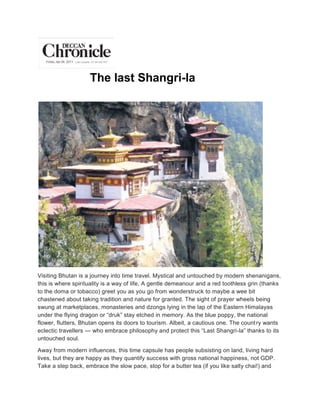
The last Shangri-La: Deccan Chronical
- 1. The last Shangri-la Visiting Bhutan is a journey into time travel. Mystical and untouched by modern shenanigans, this is where spirituality is a way of life. A gentle demeanour and a red toothless grin (thanks to the doma or tobacco) greet you as you go from wonderstruck to maybe a wee bit chastened about taking tradition and nature for granted. The sight of prayer wheels being swung at marketplaces, monasteries and dzongs lying in the lap of the Eastern Himalayas under the flying dragon or “druk” stay etched in memory. As the blue poppy, the national flower, flutters, Bhutan opens its doors to tourism. Albeit, a cautious one. The count ry wants eclectic travellers — who embrace philosophy and protect this “Last Shangri-la” thanks to its untouched soul. Away from modern influences, this time capsule has people subsisting on land, living hard lives, but they are happy as they quantify success with gross national happiness, not GDP. Take a step back, embrace the slow pace, stop for a butter tea (if you like salty chai!) and
- 2. listen to old Hindi songs (yes, the Indian influence is everywhere). Bhutan is a reverie of soulfulness that asks for responsible tourism. Traffic-free roads take us to Dzongs or fortresses reflecting a life worth preserving. The wind chill is at its peak, as we amble towards Tashichhodzong or fortress of glorious religion. This is where the fifth Druk Gyalpo (Dragon King) Jigme Khesar Namgyel Wangchuck was crowned in 2008. Cherry blossoms are in full bloom. The original dzong was built in 1216. Walk into the dzong, as men dressed in ghos and women in keras pass by. Admire the woodwork and artistry. And try Ema Datsi, a preparation of chillies in cheese with red rice or Kewa Datsi (potato, cheese and chillies). A good night’s sleep rejuvenates us for Punakha. We stop at the Dochu La pass and the 108 Chortens. With the Himalayas forming an awe-inspiring backdrop, the sparkling 108 Chortens are a tribute to the earlier King Jigme Singye Wangchuk. Thousands of prayer flags flutter, a belief that the wind gathers spiritual power and helps ward off evil. Bright red rhodendrons dot the drive to Wangdue Phodrang as we are told about the Snowman’s trek (49 days), the most difficult trek in the world. Wangdue Phodrang Dzong was built in 1638. As most dzongs are the seat of monastic learning, tradition has it that a family sends one member to become a monk. The Guru Tshengy Thondrol, depicting Guru Rimpoche, is unfurled on the final day of the Tsechu festival here. Next is a sight to behold. The Punakha Dzong or the Pungtang Dechen Photrang Dzong. On an island between the confluences of two rivers, a male called Pho Chhu and a female Mo Chhu, one can see the impulsive female as it meets the sombre male! On the way back, we spot various phallic symbols. They are signs to ward off evil and help fertility. Drukpa Kinley, also called the Divine Madman for his sexual practices, is behind this practice. Taktsang Monastry also called Tiger’s Nest sits glorious and peaceful on the edge of a 1,200m cliff and is the unofficial symbol of Bhutan. It is the seat where Guru Rinpoche meditated on his second visit to Bhutan in 747 CE on the back of a tigre ss. An arduous trek gets one to a vantage point where you can sip hot tea and even get a local Bhutanese massage with rock salt. The monastery in the rocks is serene as monks chant. Emanating peace and happiness. Bhutan’s tagline, “Happiness is a place” be comes ever so real. Getting there Make My Trip has started special charters. A seven night package at `33,333 (from Delhi) and Rs 39,999 (from Mumbai). Permits are required for travelling and entering monuments so this works wonders. Accommodation: Thimphu has Taj and Terma Linca. What to buy: Bhutanese whisky K5, local rum or ara. A handwoven stole, Yak cheese, deshu paper and Buddhist artifacts. Prices are steep.
